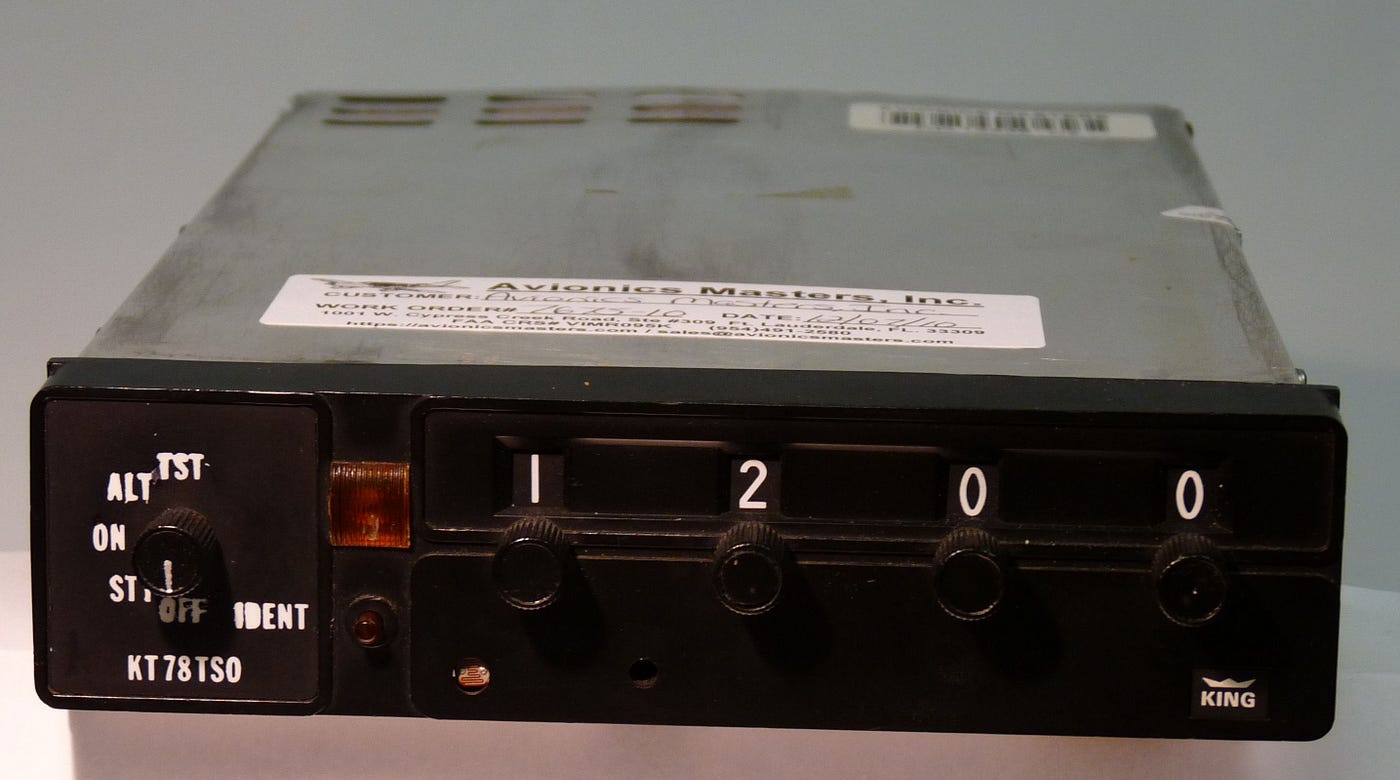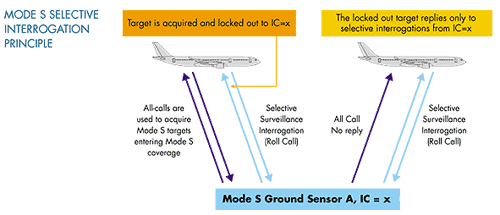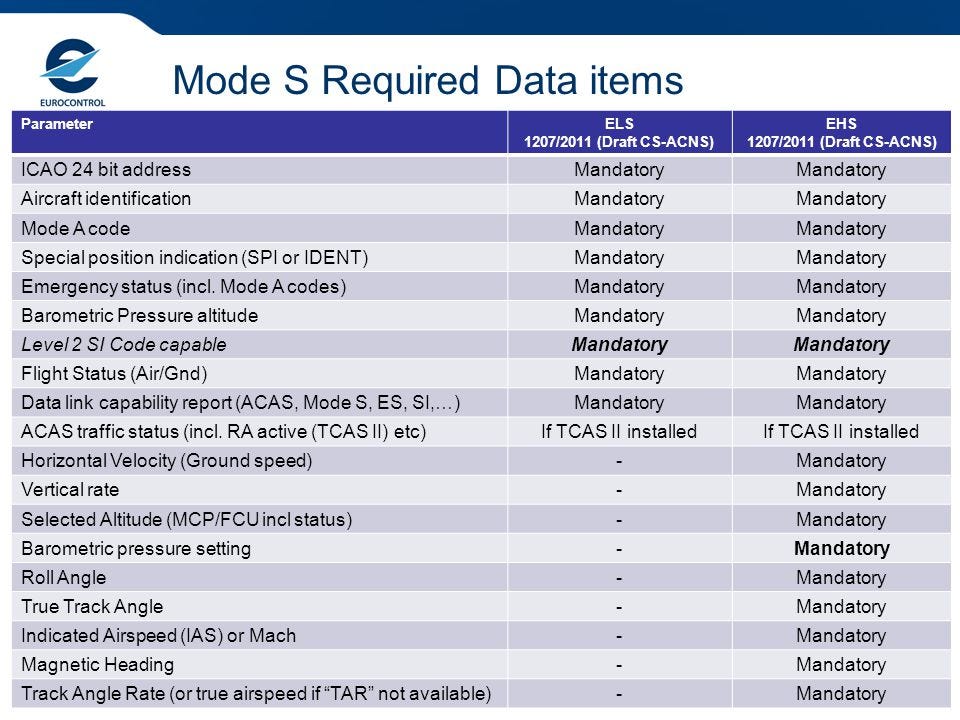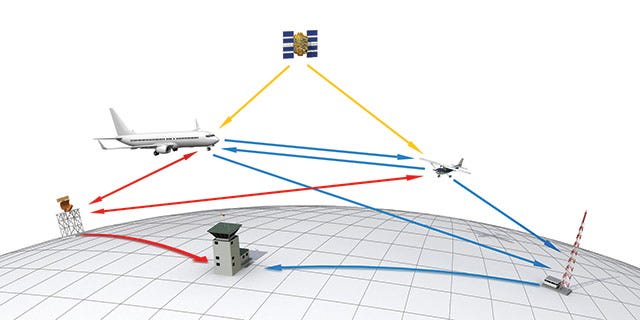Are Mode C Transpondet Registered To The Plane There In.
Mode A/C, Fashion South and ADS-B, The Alphabet Soup of Secondary Surveillance
Historical Background
Historically, communications was the second most sought requirement later on navigation. It was used to control traffic and forbid collisions, disseminate weather condition information and handle operational letters.
In the beginning, an air traffic controller could contact an shipping and request its position, which was determined past flight crew from its navigation systems. Because the position from those sources was not highly accurate, shipping under air traffic command(ATC) had to be widely separated from other aircrafs to prevent collisions near crowded major hubs. Some method of locating shipping not requiring vocal communication with crew was badly needed.
Radio detection and ranging(chief radar) was developed during World War 2 for this purpose. Altitude and position of the aircraft was calculated with acme angle( ε ) of the radar and the altitude(R) betwixt radar and aircraft(which was estimated by radiowave travel time multiplied past speed of lite). This is simplified formula all the same, the original formula takes curvature of the globe and refraction of the radiowaves in the temper into account.

A second problem was difficulty of positively identifying an aircraft. Principal radar reflections of both hostile and friendly aircrafts were roughly same. Identification of Friend or Foe(IFF) forth with secondary radar is developed to solve this problem.
Mode A and Mode C
IFF system has 5 modes, Mode 1 through Manner 5. We volition focus on Mode 3 in this article since it is the most popular ane and it is adopted by civilian aircrafts too.
Mode 3 has 2 different submodes. The first one is Way A, which is is 4 digit, octal code(digits are betwixt 0–vii) that provides temporary identity. Mode C is pressure altitude data of the aircraft.
IFF equipment is called transponder, brusque for transmitter-responder. Before or during each flying, pilots may be instructed past ATC personnel to "Squawk XXXX". XXXX in this context Mode three/A lawmaking. Mode 3/A lawmaking is temporary identity of the aircraft for that ATC. The pilot then sets its transponder Manner 3/A code to requested code. This lawmaking is then sent as respond to Manner 3/A interrogations by ATC. Style 3/A code can exist used for purposes other than identification. Some important Mode 3/A codes used for non-identification purposes are;
- 1200: Generally used past aircraft under Visual Flight Rules(VFR)
- 7700: Used during emergency
- 7600: User when radio communication fails
- 7500: Used during hijacking(unlawful interference) of the shipping

Mode 3/C is pressure distance data that is used together with Style 3/A. Mode 3/A tin can exist used alone only Mode 3/C tin can just be used with Manner 3/A. This altitude information has 100 anxiety increments.
Pilots can activate or conciliate Mode iii/A and Way three/C responses from the transponder. But if they are activated, transponder responds to Mode three/A and Mode 3/C interrogations with Mode 3/A and Fashion iii/C replies to share identification and altitude information.
Secondary Surveillance Radar(SSR) is used to interrogate aircraft transponders. SSR is generally placed on superlative of chief radar, therefore they look at the aforementioned direction. This system is called Air Traffic Control Radar Buoy System(ATCRBS). Both radars rotate at the same time/direction and SSR sends interrogations in a radiowave beam. Whatever shipping flying through that beam volition answer appropriately. This way, direction of the shipping(estimated by main radar) and identification/altitude data from the transponder tin exist correlated to positively identify the aircraft and gain 3-dimensional position fix of the aircraft.
Disadvantages of Mode 3/A and Mode 3/C
Although these early systems helped to resolve identification and 3-dimensional fix problem, they were inherently insufficient.
- Mode 3/C replies did not take error detection/correction. To fix this, multiple interrogations are done to pick virtually "popular" response equally the correct altitude response. This caused the response frequency to be bloated.
- Multiple aircraft in the same direction of the radar would respond to interrogations simultaneously. This creates garble, difficult to resolve which respond belongs to which aircraft.
- Mode 3/A codes are becoming insufficient in some overcrowded regions since information technology consists of 4 octal digits only(8⁴ chances).
Way South
Federal Aviation Administration(FAA) developed a new organisation which allows unique identity, selective interrogation and unmarried response. This new organization' s specs were;
- Selective interrogation: To reduce the garble, each aircraft can be selectively interrogated with their unique 24 bit Mode Southward accost.
- Larger dataset: Style S arrangement handles much larger data set up than unproblematic identification/altitude couple.
- Backward Compatibility: Mode S system can work with Mode iii A/C(ATCRBS) systems. They employ same frequency band for interrogation and responses for this reason.
- Error Detection: 24 bit CRC mechanism is used to notice errors in Mode S messages, assuasive robust communication. This removes the need for multiple interrogations and replies that are used in Way three A/C systems.
- Spectrum Efficiency: Thanks to selective interrogation and error detection, spectrum is used more efficiently.
Mode Southward Interrogation Types
Mode S systems has 2 types of interrogation: non-selective and selective. Permit'south see their specs and employ cases.
Mode South Non-Selective Interrogations
Mode S systems with their backwards capability has these non-selective interrogation types.
- ATCRBS All Call: Mode A/C transponders reply this interrogation normally. Way Southward transponders reply this interrogation every bit if they were Mode A/C transponder, with same waveform.
- ATSCRBS/Mode S All Call: Style A/C transponders answer with ID/altitude data. Way S transponders answer with ID/altitude and Mode S Accost information in Style S waveform.
- ATCRBS Only All Call: Only Mode A/C capable transponders answer this interrogation with ID/Altitude data. Style transponders stay silent
- Mode S Only All Telephone call: But Mode S transponders reply this interrogation. Mode A/C transponders does not reply.

Way S Selective Interrogation
Once the target shipping'southward Mode A Accost is known by the Mode South organisation, it is added to coil-call, a pool of aircraft Style S addresses for selective interrogation. Selective interrogation is done to acquire different portions of Mode South data set.
Case Usage of Style Southward Interrogations
Allow us assume Manner Due south interrogating organization cold starts, with no prior information stored. In that location are Mode A/C transponders and Way S transponders on aircraft in the airspace.
- ATCRBS All Phone call is used to gain Mode A identities and altitudes of all aircrafts.
- ATSCRBS/Mode South All Telephone call or Mode S Just All Call is used to acquire all Mode S addresses of Fashion South capable aircraft. These Mode South addresses are registered in whorl phone call list for later use. Registered shipping may exist locked from hereafter Mode S All Calls to reduce unnecessary replies.
- At this bespeak, interrogating organisation knows which aircraft has which adequacy. Mode A/C aircrafts are interrogated with ATCRBS Simply All Telephone call. Mode S capable aircrafts are interrogated with Mode S selective interrogation with the help of roll call list.
Style S Dataset
Way S systems handle more data then Fashion A/C transponders. These information are put into i of 255 Mode S registers, each with a length of 56 bits. In one case valid information are put into these registers, they can be selectively interrogated by Fashion S systems for their content. Mode S systems provide two different capabilities; Elementary Surveillance(ELS) and Enhanced Surveillance(EHS). EHS capable systems provide ELS capability plus other data.
- ELS: The system must provide automatic aircraft identity reporting, transponder capability report, flying status(airborne/on footing), distance report.
- EHS: The system provides ELS capability, plus Selected Altitude in Register (4,0), Roll Angle, Track Angle Charge per unit, Truthful Track Angle, Ground Speed in Register (5,0), Magnetic Heading, Indicated Airspeed/Mach No, Vertical Rate in Register (half-dozen,0).
Note: Each Mode S message, including ADS-B letters explained in the next section carry sender' south 24 bit Mode Southward accost.

ADS-B
ADS-B(Automatic Dependent Surveillance Circulate) is a role for airborne or surface aircraft, or other surface vehicles operating withing the airport surface move surface area that periodically transmits its state vector(horizontal and vertical position, horizontal and vertical velocity) and other information, according to RTCA DO-260B.
- Automatic: No external stimulus(like Manner Southward interrogations) is needed.
- Dependent: Information technology relies on on-board navigation sources and transmitting subsystems(mainly GPS, ADC).
- Surveillance: Provides surveillance information for other users
- Broadcast: The ADS-B system may or may not accept the knowledge of which users are receiving its circulate.
ADS-B systems broadcast the data grouped in certain registers below;
- Annals 0,5: Airborne Altitude, Latitude and Longitude.
- Annals 0,6: Surface Movement, Heading, Latitude and Longitude.
- Register 0,eight: Aircraft Identification and Category.
- Register 0,9: Due east-Due west Speed and Due north-South Speed or Heading and Airspeed(depending on subtype), Vertical Charge per unit, Geometric Tiptop Departure from Barometric Distance.
By the year 2020, all commercial aircraft and aircraft flying in Class A, B & C airspace are required to exist equipped with transponders having ADS-B out capability, meaning they must have circulate adequacy merely not necessarily capability of receiving and decoding ADS-B messages.

Mode S and TCAS
TCAS is short for Traffic Alert and Collision Avoidance System. TCAS employ air-to-air Fashion Due south interrogations to communicate with each other. The organization evaluates the collision threats by other aircraft' s range, velocity, track and altitude.
TCAS systems interrogate between 20 Nm and 40 Nm range. They utilise ATSCRBS/Mode S All Call interrogations. Fashion S transponder carrying aircraft and then can be interrogated with selective interrogations for more data.
Traffic Advisory(T.A.) is activated when in that location is a possible collision calculated in forty seconds. The choice is left to crew at this case, since it is easy to detect intruder(other aircraft) visually within twoscore seconds. Traffic advisory is just Traffic! vocal alert.
Resolution Informational(R.A.) is activated at 25 seconds to possible collision, when crew does non maneuver the aircraft in a manner to reduce collision probability. R.A. implies in that location is not enough time to visually spot intruder aircraft. Resolution advisory can be Climb! or Descend!.
TCAS systems broadcast R.A. through Mode Southward to other aircrafts. The receiving aircraft and so can calculate its ain R.A. that would prevent collision. For example, if an aircraft decides to climb as R.A. and broadcasts it, receiving shipping will make up one's mind descend as its R.A. so they would avert standoff.
Conclusion
Although Manner S was developed to reply to the problem of overcrowded airspace, in some locations it became bereft. To quote Mr. Douwe Lambers direct;
Introducing many drones with ADS-B will flood the 1090 MHz band with messages. This will degrade all systems working on 1090 MHz, such as Style A/C, 1/ii/3/four/five, S and TCAS. Interference is probable and in congested areas such every bit Frankfurt or the Los Angeles bowl the frequency is already congested without drone traffic.
This was a question whether we can integrate drones with ADS-B capability into current surveillance organisation. FAA goes for a different system for drones to achieve same goal, called Remote Identification. Only the problem with current Way S systems remains, will it need an upgrade in future?
Note: Yous tin can read my commodity virtually Integrating COTS Drones into ATC Network for more information on the topic.
Are Mode C Transpondet Registered To The Plane There In.,
Source: https://medium.com/@mehmetcagrikose/mode-a-c-mode-s-and-ads-b-the-alphabet-soup-of-secondary-surveillance-1defcd35b2ab
Posted by: haaghictir.blogspot.com


0 Response to "Are Mode C Transpondet Registered To The Plane There In."
Post a Comment